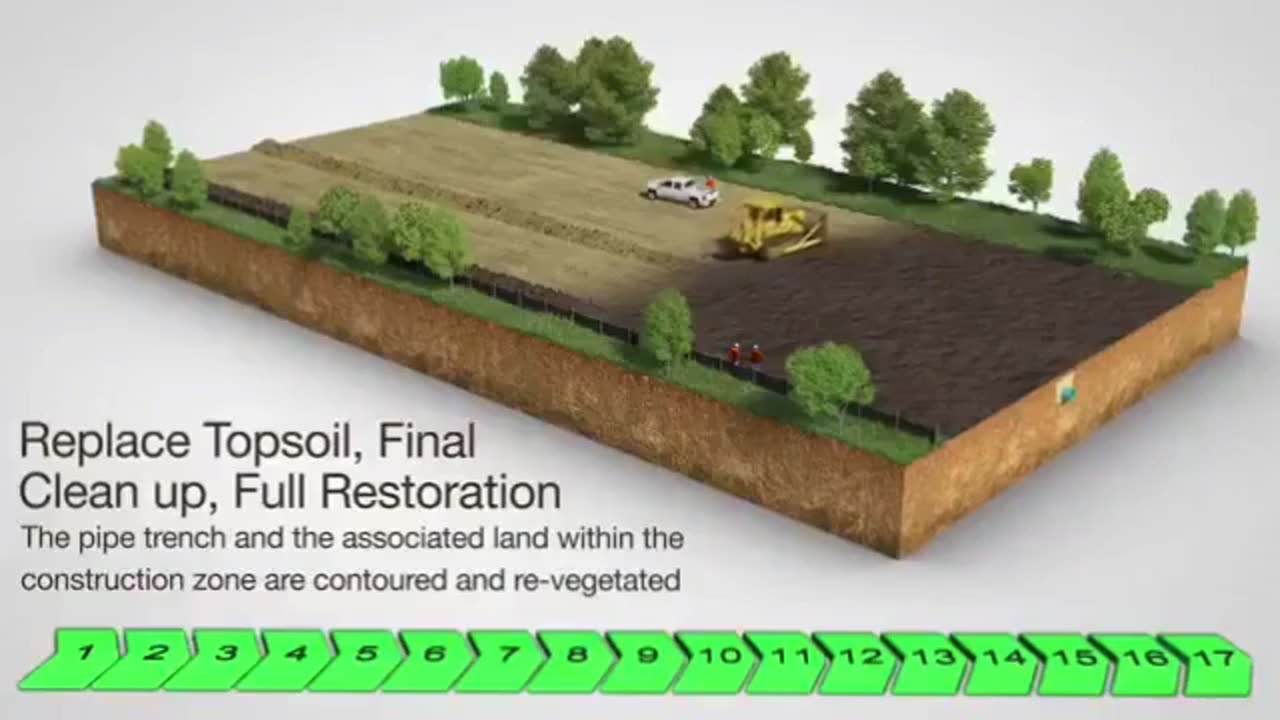Premium Only Content

Typical Pipeline Construction
Typical pipeline construction involves the process of building pipelines to transport various fluids, such as oil, natural gas, water, or chemicals, from one location to another. Here are the key steps and components involved in a typical pipeline construction project:
1. Planning and Design:
- Project Planning: Determine the route and purpose of the pipeline, considering factors like terrain, environmental impact, and regulations.
- Engineering Design: Develop detailed plans and specifications for the pipeline, including size, materials, and pressure requirements.
2. Land Acquisition and Permits:
- Acquire necessary land rights and easements to lay the pipeline across private and public lands.
- Obtain permits and approvals from regulatory authorities and environmental agencies.
3. Clearing and Grading:
- Clear vegetation and prepare the right-of-way for construction.
- Grade the land to create a level and stable foundation for the pipeline.
4. Trenching:
- Excavate a trench along the pipeline route to the required depth and width, ensuring it accommodates the pipeline and provides proper cover.
5. Stringing:
- Place the individual sections of the pipeline (usually made of steel or plastic) along the trench, ready for welding.
6. Welding:
- Weld together the sections of pipe to form a continuous length.
- Inspect and test the welds to ensure they meet quality and safety standards.
7. Coating and Wrapping:
- Apply corrosion-resistant coatings and wrapping to the pipeline to protect it from environmental elements.
8. Lowering the Pipeline:
- Carefully lower the pipeline into the trench, making sure it follows the designed path and alignment.
9. Backfilling:
- Fill the trench with soil, compacting it to provide support and protection for the pipeline.
10. Testing and Inspection:
- Conduct pressure tests to ensure the pipeline is free of leaks and can withstand the intended operating pressure.
- Inspect for compliance with safety and quality standards.
11. Installation of Facilities:
- Install necessary facilities such as valves, pumps, and compressor stations to control and maintain the flow of materials through the pipeline.
12. Restoration:
- Restore the right-of-way by re-vegetating the area and returning it to its original or improved state.
13. Commissioning:
- Test and verify the entire system's functionality.
- Begin operations, transporting the intended materials through the pipeline.
14. Ongoing Maintenance and Monitoring:
- Regularly inspect, maintain, and monitor the pipeline to ensure its safety and integrity over its operational life.
It's important to note that pipeline construction can vary significantly depending on the specific type of pipeline, the materials being transported, and the regulatory and environmental considerations in a given region. Safety and environmental protection are paramount throughout the construction process.
-
 23:09
23:09
JasminLaine
10 hours agoHe Said It… On Tape—Carney ADMITS It! Poilievre SILENCES the Entire Room
1.26K18 -
 10:50
10:50
Mrgunsngear
11 hours ago $1.27 earnedSupreme Court Rules On ATF's Frame & Receiver Rule & How President Trump Can Fix This
4.13K16 -
 26:00
26:00
CatfishedOnline
18 hours agoWoman Insists Mark Zuckerberg Profile Is Not A Romance Scam!
1.35K3 -
 8:21
8:21
Rebel News
16 hours ago $0.49 earnedPortugal’s Political Crisis: A Nation Heads to the Polls Again
8.35K3 -
 2:31:02
2:31:02
vivafrei
19 hours agoEp. 258: Taibbi Sues for Defamation! Trump Tariff Madness! Russell Brand, Greenpeace Verdict & MORE!
156K237 -
 2:27:12
2:27:12
Nerdrotic
11 hours ago $40.58 earnedCIA JFK Assassination Documents | Forbidden Frontier 097
112K66 -
 4:02:43
4:02:43
Alex Zedra
8 hours agoLIVE! Verdansk all night <3
46.2K14 -
 1:22:13
1:22:13
Sarah Westall
11 hours agoTruth about Gila Monster Snake Venom & the Miracle of Peptides for Human Health w/ Dr. Diane Kazer
94.6K27 -
 2:18:43
2:18:43
Tundra Tactical
9 hours ago $4.98 earned$3200 ZEV HEARTBREAKER Contest!!!
49.4K2 -
 6:24:39
6:24:39
EuphioniaStudio
8 hours ago $6.48 earnedIt's BAAAASED, MARIO! | Mario Party 4
48.3K6